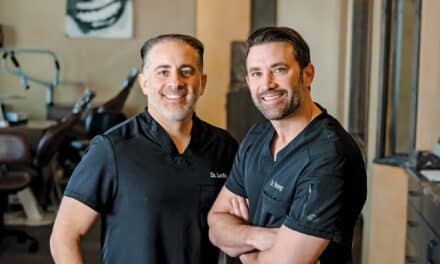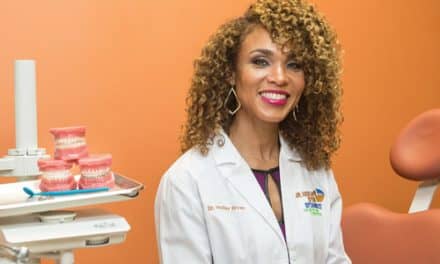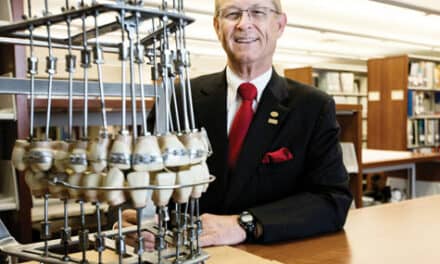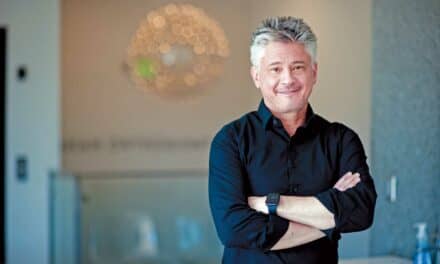Brian Rochford, DDS, MSD, helped shape his practice into a modern digital operation, but purchasing supplies remained a pain point until he used Details.
By Steven Martinez | Photos by Kelley Schuyler
If there is one defining feature of this latest generation of orthodontists, it seems to be a move toward efficiency, and Brian Rochford, DDS, MSD, of Glander Rochford Orthodontics in Indianapolis, Indiana, is emblematic of that metamorphosis.
“In my personal life, I love efficiency,” says Rochford. “I’m absolutely about the mindset: work smart, not hard. Let’s get a job done really well, but let’s be efficient in how we do it. Sometimes people do something a certain way because they’ve always done it that way.”
Either through newer methods for treatment, smarter equipment, or business and clinical software, a practice in 2023 is far more sophisticated in operation. Rochford spent a lot of time modernizing his business and taking advantage of the tech to smooth out operations on every level. Still, for his and many other practices embracing the future, old pain points still exist.
The impact of an overbite
But that wasn’t the orthodontic world Rochford was introduced to while growing up in Greenwood, Indiana. A suburb on the outskirts of Indianapolis, it’s an aptly named town marked by seemingly endless leafy greenery and grassy roadsides.
His mother was a dental hygienist, so he grew up around the dental profession, but another significant influence on his life was the practice he now calls home. When he was eight, he started treatment at Glander Orthodontics with his future partner Karl Glander, DDS, with a bionator to correct an overbite. In fifth grade, he had an early round of braces due to his adult teeth coming in late, and by high school, he was in a full set of braces.
“I was just in this office for a long time, a big part of my life in three different chunks. So, I was intimately a part of this practice as a child,” says Rochford.
The time he spent with his mother in her office and orthodontic treatment as a child clarified his goal of having a life centered around dentistry. While it’s not an uncommon origin story for an orthodontist, the impact of the treatment on his young life kept him focused from high school onward.
He was accepted to dental school at Butler University, kept his grades up, and tried to build the kind of resume he felt might help him get into an orthodontics program.
“I just kept hustling. I knew for a long time I wanted this,” says Rochford. “The question was, would I be able to make it happen? And I made it happen.”
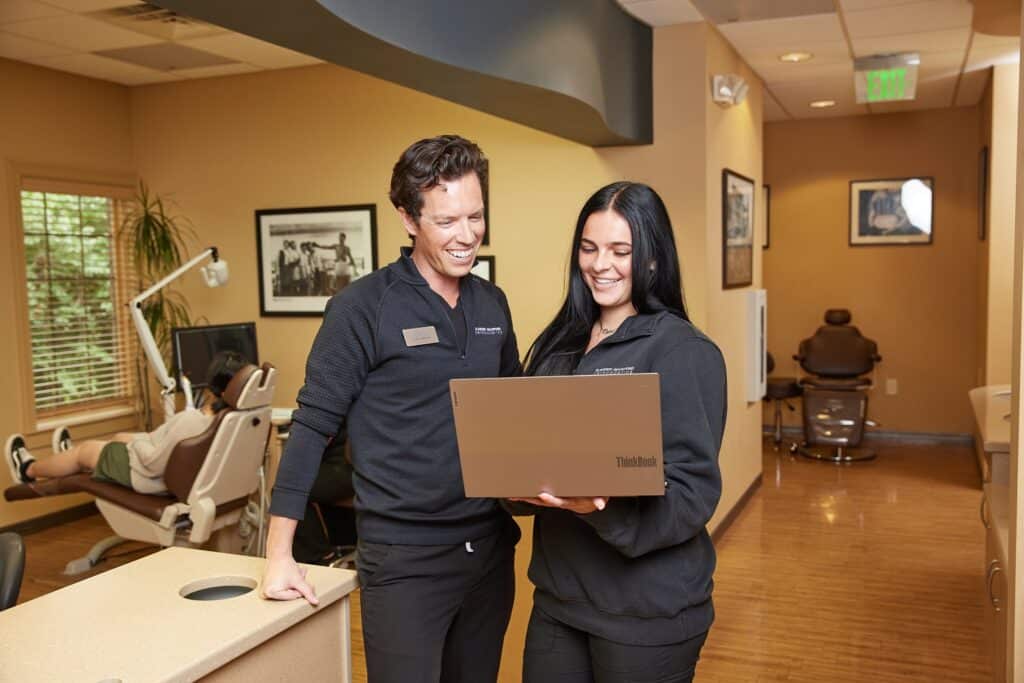
Learning the business
Rochford and his wife moved to Colorado University so he could attend the Colorado School of Dental Medicine. Through mutual connections, Rochford managed to stay in contact with Glander throughout his time in dental school and in Colorado. Before he graduated, Glander agreed to a 5-year plan to bring Rochford into the practice as an associate first and then as a partner. Glander, who had been running his practice since 1993, was approaching retirement, and Rochford was up for the challenge of taking the baton of his hometown orthodontist.
One of the things that Glander advised Rochford of early in their partnership was that having a practice was as much about running a business as it was clinical treatment, and the former was more likely to cause him stress than the latter.
Rochford admits that he came into it with no business experience. He hadn’t taken a business or accounting class in all his years of schooling, preferring science classes and a second major in Spanish.
“I kind of got thrown in the deep end, but it’s ended up being something I really love,” says Rochford.
But he possessed an instinct for efficiency and ambition to put his stamp on Glander Orthodontics. He says when he first joined, he asked many questions about why things were being done one way and not another and eventually suggested some new methods, both clinical and business-related.
“Luckily for me, Dr Glander was very open to suggestions on how we could do things differently,” he says.
When he arrived, it was still a very analog practice. They were using paper charts and metal brackets and wires. They still had alginate impressions and were not yet offering aligner therapy. Rochford brought in a digital scanner and 3D printing and replaced paper charts with digital files. These days they offer 3D-printed Lightforce brackets and Invisalign Aligners and even use 3D-printed metal appliances from Motor City Lab Works in Detroit.
But the last piece of the practice that remained stubbornly analog was the supply ordering process.
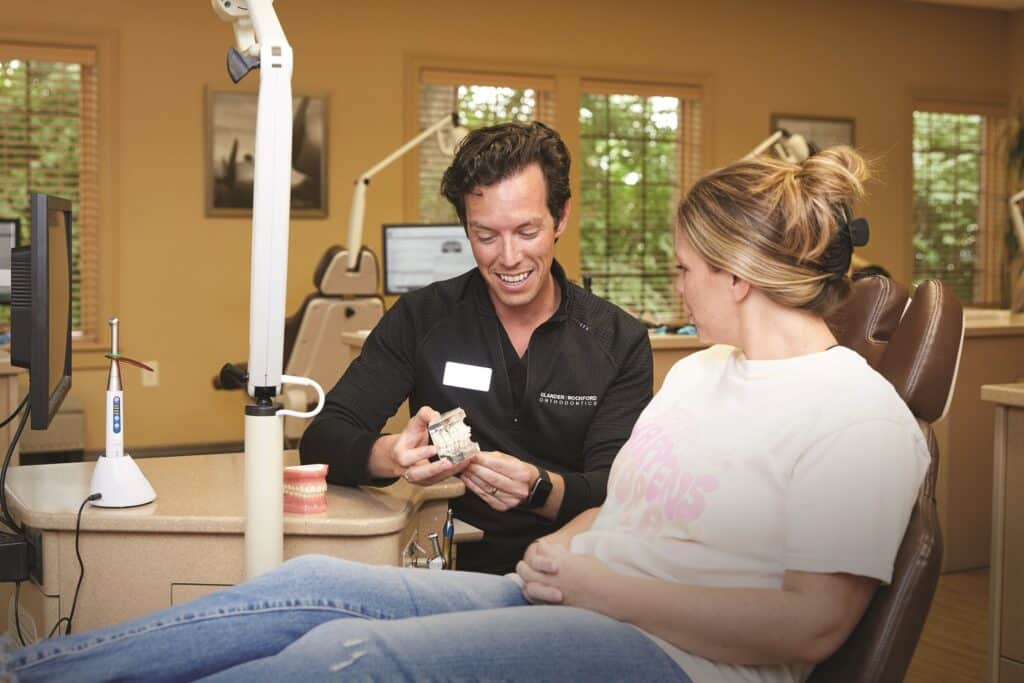
Purchasing supplies the old way
For Rochford’s staff, purchasing supplies had always been an inefficient but necessary process. The job was tasked to one of the lead clinical assistants, Andrea, who would go through binders, papers, and lists scattered all over the place for the different vendors. The most painful aspect of the task was that each vendor wanted to communicate differently. Some wanted her to call, others preferred email, some had a rep that was reached through text, and still others retained a preference for fax.
The staff tried their best to keep it organized by using spreadsheets, but when it was time to order supplies, the process could take up to a full day for his clinical assistant to complete. Sometimes she would stay after clinic hours just to finish up and not miss as much time doing her actual job.
“They’re trying to see all these patients and then also manage this inventory system. That’s not what they know how to do. They’re not inventory specialists, they’re clinical assistants,” says Rochford. “So bringing on a digital solution to an analog problem. It just made sense. Details allowed us to be much more efficient and to work a lot smarter and not harder as they were before.”
Rochford first saw the Details Ordering Platform at the AAO Annual Session in Miami in 2022. At the show, he came across Jeff Biggs, DDS, MS, a fellow Indianapolis orthodontist and Details founder. Biggs showed Rochford a demo of the platform and he began to understand the value it could have for his practice.
“He was just telling me about it, and I was there with my wife, and we’re both thinking this would save us so much time and energy,” recalls Rochford. “I loved that as an orthodontist, this is a company he founded because he knew this was a pain point for his practice. So it made a lot of sense to me.”
How Details outsources ordering
Details is an ordering platform that allows practices to order everything in a single place without changing suppliers. It also helps practices find the best available prices for the supplies and track their spending. The platform is supplier agnostic so that orthodontists can stick with their preferred suppliers, but it also allows orthodontists to find better pricing or products if the practice is in need of a change. Details also offers a dedicated ordering concierge to assist with purchasing, respond to a practice’s needs, and research better prices.
Rochford’s assistant can buy supplies through the platform, and if it’s something they order all the time, she can choose it from the list of previous orders, click to reorder it, and be done. The concierge will then make sure the order is correct and verify it. Compared to the grueling task it was before, ordering with Details takes “a laughable lack of time,” says Rochford.
If a doctor wants to change a supplier for any reason, say better quality or better pricing, the concierge is tasked with taking the request and researching options. In the age of ChatGPT, it’s worth mentioning that the concierge isn’t an AI or chatbot but a real person. Rochford’s concierge is Amy Swinford, who he and his staff have been able to meet in person since Details and Swinford are based in Indianapolis.
“Amy works directly with our practice and now knows our practice and what we like and don’t like,” says Rochford. “They’re looking out for what’s best for us. They have no allegiance to any product, which is amazing because I don’t have the time to do that type of research.”
Details says that each concierge on their staff manages anywhere from 20-30 different practices, but because a practice only works with a single concierge, they can become familiar with each clinic’s preferences. Most of the concierge team has a clinical orthodontic background. The concierge is meant to act as an extension of the practice. Their goal is not strictly to find the cheapest price but to align with a practice’s goals. So far, 112 practices are using Details, representing over 160 offices in the US.
The Details Ordering Platform has a dashboard that helps practices track spending across suppliers, offices, and product categories. It also tracks how often practices order supplies, their specific product preferences, when they might be looking to make a change, and price sensitivity. Rochford finds a lot of value in having as much data as possible to help him make decisions to improve his business.
“I want to run my business like a real business,” says Rochford. “I joke that for a long time, a lot of orthodontists were just running multimillion-dollar lemonade stands. They just turned on the open sign, and that was kind of it. But we are running multimillion-dollar companies, and we should run our business like that and use data to make informed decisions as a part of that. I don’t need an MBA from Harvard to figure that out.”
The data that Details offers helps Rochford’s practice to track the cadence of ordering and understand when it’s time to order and avoid scrambling at the last minute when something runs low. It also helps Rochford see in real-time the amount of money he is spending on products down to a granular level and know where that money is going.
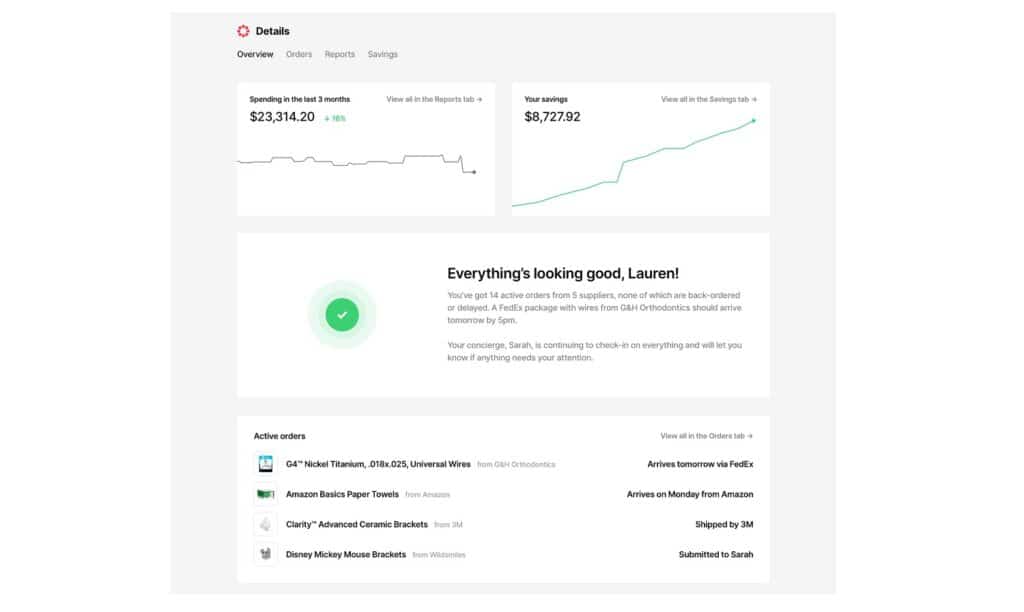
The value of efficiency
At this point, Rochford says that Details more than pays for itself each month, regardless of how much money it saves him through supply prices. The platform also operates as a safeguard against staff moving on from his practice, an especially key benefit when it is so hard to hire new people.
“If Andrea quit tomorrow and Details didn’t exist, I would have no idea where we get our gloves. I have no idea where we get our wires,” says Rochford. “That might not be true for everybody but it’s probably true for a lot of doctors because we have so many things going on.”
With the old method, the knowledge that his lead assistant had when it came to the ordering process, would have been difficult to retrain. But now, not only is it simpler for his staff, but the knowhow stays with Details, making any potential transition smoother. It saves his clinical staff time so they can work with patients, and it gives him peace of mind knowing that if any of his staff were to leave, he wouldn’t have to retrain someone else on a complicated ordering system.
“For me, it’s never felt like Details are trying to sell me something,” says Rochford. “This is truly a pain point I had in my practice and learning that there was this really awesome solution was a game changer for me.”OP


